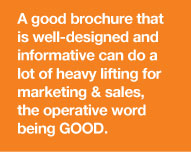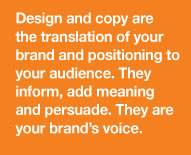What Makes a Great Brochure?
There is hardly a company out there that couldn’t make excellent use of a good product or service brochure. In fact, a well designed, informative brochure is often the cornerstone of a company’s marketing effort. They can be used for a single purpose, such as a leave-behind piece for sales calls, or for multiple uses. They can be mailed to prospects to spark interest, handed out at events and trade shows, mailed to fill information requests and more. A really good brochure can do a lot of heavy lifting for marketing and sales, the operative word being GOOD.
A marketing piece as important as this will be viewed carefully and will reflect the quality and value of your company’s products and services in the recipient’s mind. It can establish your credibility and professionalism, or destroy it. It can make the big sale, or break it. So, when it’s time for your company to produce a new brochure, make it a top priority to get it right the first time.
 What goes into the design of a high-quality brochure?
What goes into the design of a high-quality brochure?
A quality brochure will use a combination of design, visuals, text and layout to create a look and feel that emphasizes your marketing objectives – introducing a new product, selling a service, creating brand awareness or soliciting donations. The objectives can vary as widely as the designs, what matters is that your brochure communicates effectively to your target audience. Often, having an outside firm write and design your brochure will help you avoid the trap of using industry jargon and acronyms. They will help you to view things from the prospect’s point of view instead of a salesperson’s.
When starting your brochure project begin by identifying your target audience. Who is this brochure aimed at? CEOs, housewives, human resources managers, affluent males over 50? Know your audience and speak to it, specifically. You may find that you have more than one distinct target audience you need to engage, such as a CEO and an IT manager. These two individuals would have very different concerns and levels of technical expertise. In that case think seriously about creating more than one brochure to appeal to each audience and address their specific questions and concerns. Remember, you need this heavy-hitting brochure to be effective. Creating more than one version may get you a higher ROI than producing just one, all-purpose brochure.
When you’ve determined who you are talking to select the most valuable benefit they derive from your product or service. You may want to do research here with past customers to determine that benefit, it’s not always what you think it will be. Your product may help a busy executive stay organized, but the real benefit to the customer may be the time your product saves him, or the freedom that organization gives him. If you take the time to identify why past customers bought your product it will pay off with new prospects. Then your new brochure can make use of text, pictures, colors and design to emphasize what that benefit will mean to them.
In the initial design process be sure to involve any high-level decision makers right from the start to get the buy-in you’ll need for approval. This will help you avoid costly redesigns and other changes at the end of a project when they are the most expensive and time consuming to make.
As we said in the beginning your brochure will do some heavy lifting for your sales and marketing departments, so don’t strain it too much. Avoid the temptation to overload your brochure with every fact, feature and detail of your offering. Give prospects the information they need to get excited about your product and persuade them to take the next step in your sales process. That could be calling to place an order, visiting a web site, setting up a sales appointment, or visiting a store location. Whatever your sales cycle calls for, make sure your brochure prominently asks your prospect to move forward – this is a Call To Action. That’s what you’re really after, so be sure to ask for it.
 A brochure allows you to leave a lasting impression on your prospects. That means a poorly executed brochure will actually do more harm than good, costing your company much more than the price of producing a high-quality piece in the first place. Be sure to check out the materials of the competition. The idea here is not to copy them, you always what to differentiate your company, but to make sure that your materials are as good or better than theirs. You will get the best ROI by using professional designers, photographers, copy writers, proofreaders and printers for your project. Help them gather all the information they need about your company, brand and product, then with guidance from you, let them do their stuff! The next time a prospect asks you for more information, you’ll be proud to present them with your impressive new brochure and you’ll know your well on your way to a new sale.
A brochure allows you to leave a lasting impression on your prospects. That means a poorly executed brochure will actually do more harm than good, costing your company much more than the price of producing a high-quality piece in the first place. Be sure to check out the materials of the competition. The idea here is not to copy them, you always what to differentiate your company, but to make sure that your materials are as good or better than theirs. You will get the best ROI by using professional designers, photographers, copy writers, proofreaders and printers for your project. Help them gather all the information they need about your company, brand and product, then with guidance from you, let them do their stuff! The next time a prospect asks you for more information, you’ll be proud to present them with your impressive new brochure and you’ll know your well on your way to a new sale.






